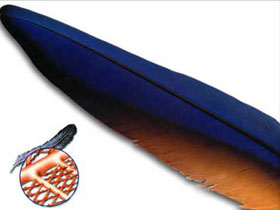The theory of evolution maintains that birds evolved from reptiles, but is totally unable to account for the enormous differences between these two separate living classes. One feature that widens the unbridgeable gulf between birds and reptiles is feathers, which are unique to birds.
The structure of bird feathers is far too complex to be explained by means of any evolutionary process. The well known ornithologist Alan Feduccia does not consider it probable that a tissue so well suited for flight could have emerged initially to serve another purpose (for example, insulation, as is claimed by evolutionists). As he says: "Everything about them indicates an aerodynamic function... They're lightweight, they're excellent airfoils, they produce high lift at low speeds, and they have a Velcro-like quality that lets them be reassembled."95
In addition, a long, stiff tube runs along the center of the feather. From both sides of this tube emerge hundreds of barbs. These barbs, which have differing lengths and degrees of softness, give the feather its aerodynamic properties. Even more interestingly, on each barb are even smaller structures known as barbules, too small to be seen with the naked eye. On all of these barbules are tiny hooks, thanks to which the barbules are held together tightly, as if by zippers.
There are 650 barbs on either side of a stork feather's stem. Each one has 600 contraposed barbules, attached to one another by 390 hooks which, again, cling together like the two sides of a zipper. If the hooks become detached from one another, the bird has only to shake itself or groom its feathers with its beak for them to reattach.
To maintain that such a complex structure evolved as the result of random mutations from reptile scales is simply a dogmatic belief, based on no scientific foundation at all.
A. H. Brush, a Connecticut University professor of physiology and neurobiology, described the profound differences between reptile scales and bird feathers:
Every feature from gene structure and organization, to development, morphogenesis and tissue organization is different [in feathers and scales. . . the protein structure of bird feathers and are unique among vertebrates . . . Feathers appear suddenly in the fossil record. . . . 96
This superior creation in feathers gave Charles Darwin considerable pause for thought. The magnificent beauty in peacock feathers actually made him "cold all over," as he put it. In a letter to his friend Asa Gray dated 3 April, 1860, he wrote:
95. Pat Shipman, Ibid., p. 26.
96. A. H. Brush, "On the Origin of Feathers," Journal of Evolutionary Biology, Vol. 9, 1996, pp. 131-132.
97. Norman Macbeth, Darwin Retried: An Appeal to Reason, Harvard Common Press, 1971, p. 131.


